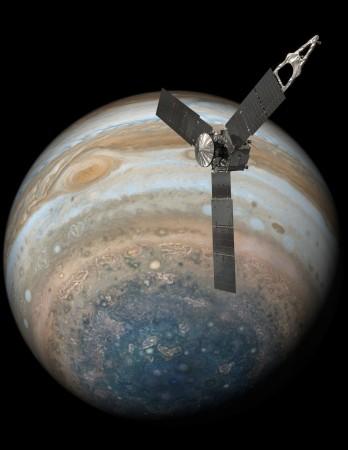
On July 10, NASA's Juno completed a close flyby of the gas giant Jupiter and explored its phenomenal Great Red Spot (GRS) while completing its sixth science orbit.
This was the first ever close analysis of the GRS which took place in the Juno mission. All the instruments of the spacecraft were functioning during this flyby and the data accumulated are being transmitted to Earth.
The raw images of Jupiter and GRS taken by the spacecraft will be posted in the coming days. The next flyby mission of the Juno spacecraft will occur on September 1, 2017, a NASA statement revealed.
"For generations, people from all over the world and all walks of life have marvelled over the Great Red Spot," said Scott Bolton, principal investigator of Juno from the Southwest Research Institute in San Antonio. "Now we are finally going to see what this storm looks like up close and personal."
The GRS storm was measured to be as wide as 16,350 kilometres (10,159 miles), when it was measured on April 3 this year. It is believed to exist for more than 350 years and has been analysed since 1830. As per the modern belief, this spot appears to be shrinking.
NASA's Juno spacecraft reached an orbit closest to the centre of Jupiter – perijove – at a distance of 3,500km (2,200 miles) on July 10, 2017. Juno flew over the cloud tops of the gas giant at 9:55 pm EDT (7:25 am IST).
It covered another 39,771 km (24,713 miles) 11 minutes, 33 seconds later and flew by the crimson clouds of the GRS at a distance of 9,000 km (5,600 miles) above the clouds.
On July 4 at 10:30 pm EDT( 8 am IST), Juno logged exactly one year in Jupiter orbit, marking 114.5 million km (71 million miles) of travel around Jupiter.
Juno was launched on August 5, 2011, from Cape Canaveral, Florida. During its mission of exploration, it soars low over the planet's cloud tops -- as close as about 2,100 miles (3,400 km). During these flybys, Juno is probing beneath the obscuring cloud cover of Jupiter and studying its auroras to learn more about the planet's origins, structure, atmosphere and magnetosphere.
Early science results from NASA's Juno mission portray the largest planet in our solar system as a turbulent world, with an intriguingly complex interior structure, energetic polar aurora, and huge polar cyclones.
JPL manages the Juno mission for the principal investigator, Scott Bolton, of Southwest Research Institute. The Juno mission is part of the New Frontiers Program managed by NASA's Marshall Space Flight Center in Huntsville, Alabama, for the Science Mission Directorate. Lockheed Martin Space Systems, Denver, built the spacecraft. JPL is a division of Caltech in Pasadena.














